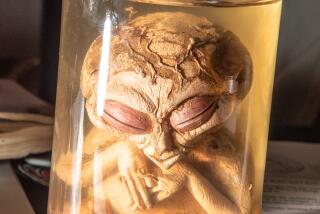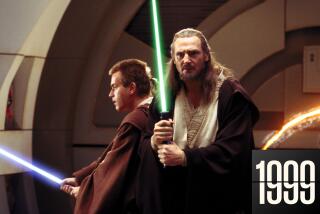The descent of a sci-fi guru
He was a onetime utopian socialist who became an assertive right-winger, a libertarian nudist with a military-hardware fetish, a cold warrior who penned an Age of Aquarius sensation with a hero who preached free love.
He won admiration from Ronald Reagan, who enlisted his ideas in his “Star Wars” missile shield, and Charles Manson, who was captured with the novel “Stranger in a Strange Land” in his backpack. He predicted the European Union and invented the water bed.
But Robert A. Heinlein, the California-based science-fiction writer who stood over the midcentury decades like a colossus, casts a different kind of shadow now, on the 100th anniversary of his birth, as his archives, held by UC Santa Cruz, are being placed online, making his work even more accessible to scholars and fans. Most of his work is in print, but opinions vary wildly about how important a writer Heinlein was: He’s both a life-changing inspiration and a “dinosaur” who exerts less cultural presence than, say, Philip K. Dick, the drug-addled oddball who was a footnote during the field’s golden age.
Heinlein, who in life was a divisive figure, has become, in death, a polarizing one and even something of a punch line. “When an emerging science-fiction writer’s work earns him comparisons to Robert A. Heinlein,” Dave Itzkoff begins a 2006 New York Times review, “should he take them as a compliment?”
As the literary and academic worlds open to science-fiction and genre writing, Heinlein lacks the cachet of J.G. Ballard, Ursula LeGuin, Octavia Butler, Neal Stephenson, cyberpunk pioneer William Gibson and others. Films based on Dick’s books, good and bad, keep coming. But Heinlein’s film adaptations, in the last half century, since 1950’s “Destination Moon,” culminated in 1997’s “Starship Troopers,” widely disliked by his fan base.
Non-SF writer William Burroughs probably has more influence inside the genre’s literary wing than Heinlein, who won four Hugos (the award voted by the fans), sold millions of copies, and was termed the field’s most significant writer since H.G. Wells.
“His rabid fan base is graying,” said Annalee Newitz, who writes about science fiction for Wired and Gawker. “To literary readers, the books look cheesy, sexist in a hairy-chest, gold-chain kind of way. His stuff hasn’t stood the test of time,” because of characters’ windy speechifying and their frontier optimism.
“Here at the store I actively resist promoting him, because he was a fascist,” said Charles Hauther, the science fiction buyer at Skylight Books. “People don’t seem to talk about him anymore. I haven’t had a conversation about Heinlein in a long time.”
Still, hard-core admirers remain: David Silver, the Venice-based president of the 800-member Heinlein Society, discovered the author’s work as a boy in the ‘50s and said he rereads about four dozen of Heinlein’s books every year.
And Heinlein’s following shows up in unexpected places: He’s the hero of numerous astronauts, Silicon Valley types and those seeking to privatize space travel. He isn’t just their favorite writer; he set them on their life’s course. He generated public enthusiasm for the space race, inspired the genre called “military science fiction.” Tom Clancy, Microsoft co-founder Paul Allen and countless libertarians are fans. A crater on Mars is named for him.
Tom Disch, author of the respected critical study “The Dreams Our Stuff Is Made Of,” said Heinlein’s early work was often brilliant. “His great misfortune is the people who like him: It’s often old-fashioned, cantankerous, right-wing chest-beaters. He was a better writer than that would suggest. He had a gift for startling notions.”
‘He was the enemy’
There are plenty of reasons for the polarized feelings over Heinlein, who was born in Missouri, attended the U.S. Naval Academy, left the military after a bout of tuberculosis and spent several decades in L.A. and Santa Cruz. After campaigning for Upton Sinclair and running for the California Assembly, he dominated the pulp magazines, broke into the Saturday Evening Post and became the first science fictionist to land on the New York Times bestseller list.
Some of the divisiveness around Heinlein comes from a battle that redrew the field profoundly over politics and gender.
In the ‘40s and ‘50s, science fiction’s “golden age,” there were three faces on the genre’s Mt. Rushmore: Arthur C. Clarke, Isaac Asimov and Heinlein. His books are far more likely than the others’ to have the word “controversial” in their jacket copy.
“He was the enemy,” recalled Disch, who was an emerging novelist in the “new wave” of the 1960s.
Those writers, often liberal or radical, aimed to move away from pulp space operas and toward literature, from tales of physics to stories about psychology and sexuality and drugs.
There were more female writers, and the men exhibited a feminist consciousness that diverged sharply from the golden age, in which women were usually sex objects, foils to rugged male heroes or absent altogether.
Even “Stranger,” with its countercultural following and endless debates about alternative sexuality -- it’s one of several of his books to dramatize group marriages -- enrages feminists these days. “It’s like the sexist model of hippie life,” said Newitz. “ ‘We’re all liberated, but the women still get the coffee.’ ”
Though he became a symbol of all that was backward to the new wavers, some cite him as a major influence. “He was the enemy -- yes,” said Samuel R. Delany, a leader of the ‘60s insurgence who is also black and gay. “But he was the enemy to be bested at his own game. We took his rhetorical tricks, his ways of dramatizing an argument, and then used them to dramatize arguments he would have hated.”
Despite a backlash of masculine, hard-science-driven work in the early Reagan era, the new wave effectively won the war when cyberpunk and its variations became the dominant strains over the last few decades.
“He was certainly temporarily defeated by that generation,” said Newitz. “But we’re really going through a renaissance of space opera” in movies and television and books by writers such as Iain M. Banks and Ken MacLeod, who lean as far to the left as Heinlein did to the right.
“Any form goes through phases, and we’re seeing a backlash against cyberpunk. We’re sick of implants. We want to go to another galaxy. This new generation is writing stuff that’s more literary and more relevant to issues we’re grappling with as a culture.”
The core of his following
For years, the intellectually ambitious novels of the 1960s, especially “Stranger in a Strange Land,” about a spiritually and sexually messianic Martian-born human, and “The Moon Is a Harsh Mistress,” which concerns a free-market revolt by prisoners on the moon, were considered Heinlein’s great work.
These books still have followings; “Moon” sits in the International Space Station library.
But the bestselling “Stranger,” which Kurt Vonnegut Jr. reviewed on the cover of the New York Times Book Review in 1990 when it was reissued in an expanded edition, now reads like a long-winded relic of the ‘60s, philosophy for junior high kids.
Meanwhile, the books aimed squarely at a youth audience, the “juveniles” of the ‘40s and ‘50s, such as “Red Planet” and “Orphans in the Sky,” have seen their stars rise.
“There’s always this Heinlein character pontificating,” said Junot Diaz, who immersed himself in the books as background for his recent novel “The Brief Wondrous Life of Oscar Wao.”
“I never liked that. And he always cut that down in his juveniles. He was so much more humane” in those books.” “One of my favorites was ‘Have Space Suit Spacesuit -- Will Travel.’ I used to have dreams about that book.”
George Slusser, who’s taught science fiction at UC Riverside for 25 years and sees Heinlein as reflecting many currents of American literature, concedes that many of the late books are self-indulgent and solipsistic. But his students continue to respond to Heinlein’s juveniles, especially science students.
“Have Space Suit -- Will Travel,” said Slusser, “is like ‘Huckleberry Finn’ redone, even though the title is silly and it involves a kid getting a space suit by saving box tops.”
L.A. writer M.G. Lord loves the juveniles and credits their strong, self-reliant females with making her a feminist. The tendency of Heinlein heroines to use initials led young Mary Grace to do the same.
But Heinlein’s adult books are not as good, she said, and some written during and after the sexual revolution are disturbing, including “Friday,” in which a heroine falls in love with her rapist.
“The minute he could make his sexual fantasies explicit it was, ‘Oh, gross!’ ”
The serious books, especially those he wrote in the two decades before his death in 1988, seem culturally out of step. “I don’t see any of his novels as being especially relevant for my students in the 21st century,” said H. Bruce Franklin, a Rutgers professor and author of “Robert Heinlein: America as Science Fiction.”
Heinlein’s gift was to catch the zeitgeist. “That’s what made him so successful, but it makes his work seem dated.”
As space travel has moved from its Cold War centrality to the margins, his work has dated further. In short, Franklin said, the future doesn’t look as he predicted it would.
Still, even detractors see his shadow. “The idea of combining a space opera about the military with a soap opera about sex is a pretty cool thing,” said Newitz. “Film directors are still wrapping their heads around that.
“Maybe there will be a Heinlein renaissance,” she offered. “But I sure hope not.”
--
More to Read
Sign up for our Book Club newsletter
Get the latest news, events and more from the Los Angeles Times Book Club, and help us get L.A. reading and talking.
You may occasionally receive promotional content from the Los Angeles Times.










